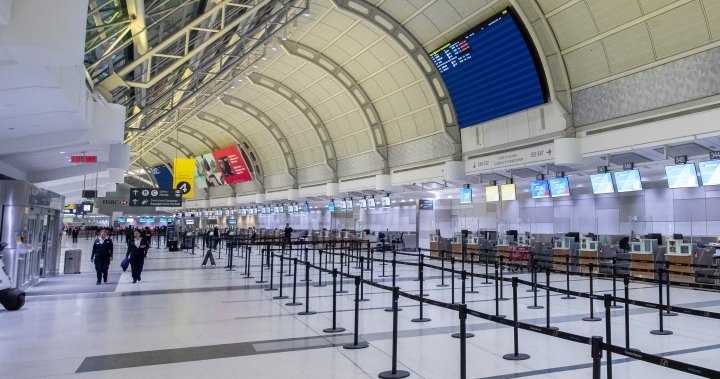Airports and airlines prepared for a surge in passengers this week ahead of spring break after a year where the industry has struggled to cope with peak travel times.
As March break kicked off in Ontario this weekend, travellers hoped to avoid a repeat of the snaking lines, lost luggage and hundreds of thousands of flight cancellations that beset them last summer and during the winter holidays.
March is typically a busy time for the airline industry as provincial spring breaks fall throughout the month and families use the time to travel.
Severe staffing shortages and high worker attrition rates were among the factors conspiring to snarl air travel as the sector began recovering from COVID-19-related travel restrictions in 2022 — with fears they could foil vacation plans yet again.
Last month, the percentage of on-time departures in Vancouver, Toronto and Montreal was well below that of airports in Seattle, Chicago, New York City and Boston, according to statistics from travel data company OAG.
“It doesn’t bode well, given that February is traditionally a quiet time of year, that in the case of the three largest Canadian airports somewhere in the vicinity of four out of every 10 flights were delayed,” said former Air Canada chief operating officer Duncan Dee.
Jessica Ng, who was waiting at Pearson with her two children and husband Friday morning, said they realized after entering the terminal that their U.S.-bound Air Canada plane was delayed for about two hours because the incoming flight had also been held up.
“I have been delayed quite often by Air Canada before as well, so I am not surprised,” she said.
But fear of losing her luggage remained top of mind, so Ng resorted to an increasingly common tactic.
“I added an extra AirTag in my checked luggage, just in case if they are lost, then I know I can track my luggage,” she said, referring to Apple’s electronic tracking device.
Ng said her confidence in Canadian airlines and airports is not strong.
“But do we have a choice?”
Last week, Toronto’s Pearson airport announced it would cap the number of flights during high-traffic hours in order to “flatten out” daily peaks and smooth the flow of passengers.
Airlines and the two federal agencies responsible for airport security screeners and border officers say they are adequately staffed to handle the flood of spring travellers, though some hedged their confidence.
“While we are well staffed and prepared for the spring and summer travel seasons, it’s important to note that wait times at any airport can occur for various reasons, even when staffing levels are optimal, and can fluctuate throughout the day based on passenger volume/number of flights,” said Suzanne Perseo, a spokeswoman for the Canadian Air Transport Security Authority (CATSA), in an email.
She said the agency has nearly 530 fewer screening officers than in 2019, when it employed 8,284 screeners, though some 700 recruits are in various stages of the certification process.“ At the country’s four largest airports — Toronto, Montreal, Vancouver and Calgary — staffing levels are at or above pre-pandemic levels, she said.
Air Canada boasted a head count of about 37,000 at the end of February compared with 35,680 in December and just over 31,000 a year ago.
“The Canadian job market is very competitive so attracting and retaining talent is a challenge for all companies,” said airline spokesman Peter Fitzpatrick in an email.
Flair Airlines CEO Stephen Jones said this week that staff turnover is one of the biggest hurdles in an industry that requires substantial training and skills across much of its workforce, from flight crews to air traffic controllers.
“Pilots are heavily in demand, and mobile … The other part really is the airport labour force, whether it’s the baggage handlers or check-in — not so much attracting people necessarily, but the level of attrition,” he said at a press conference.
“Mechanics are another that’s very much in demand _ the maintenance engineers” — who typically need a four-year college diploma or apprenticeship program as well as several years of on-the-job training.
Customer service agents receive “abysmal” training and unsustainable schedules at some airlines, said Leslie Dias, director of airlines at Unifor, which represents nearly 9,000 agents.
“We have some airline workers whose entire training happens virtually. They never even step into an airport until essentially their first day of work. So I think you can imagine what that means in terms of assisting passengers,” she said.
“And you can have a shift that’s from 3 a.m. to 7 a.m. or some crazy time that’s late at night. And they’re not always stable hours” — resulting in further turnover — she said.
Security screeners’ attrition rate in the three months between July and September was about 10 per cent countrywide, though it’s “trending down,” CATSA said.
David Lipton, a spokesman for the United Steelworkers union that represents some 2,000 screeners across 44 Canadian airports, partly agreed, pointing to wage hikes in recent collective agreements: “The situation is still difficult in terms of retention and recruiting, but it is improving.”
The number of scheduled flights by Air Canada and WestJet jumped 31 per cent to 47,362 this month from 36,062 in the same period a year earlier, according to flight data firm Cirium.
The most sought-after destinations included Paris, New York City, London, Fort Lauderdale and Orlando, Fla., and Las Vegas, according to travel search engine Kayak.
—With files from Sharif Hassan in Toronto




